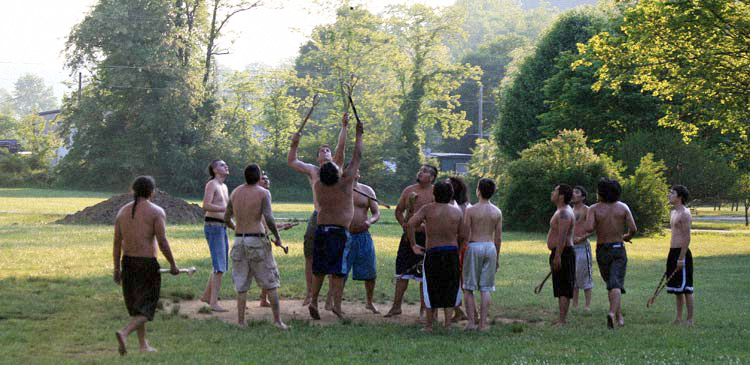 Native Americans experience the most severe poverty of all U.S. racial and ethnic groups. In particular, one-third of all Native households with children younger than five years live below the federal poverty line.
Native Americans experience the most severe poverty of all U.S. racial and ethnic groups. In particular, one-third of all Native households with children younger than five years live below the federal poverty line.
The harsh effects of poverty are well known. Poor children are more likely than others to have asthma, to be obese, and to die of infectious diseases. They are also more likely to have emotional and behavioral problems, and less likely to meet standards for reading proficiency. Their parents are more likely than others to be depressed.
The English language is rich in clichés about poverty. Two old sayings come to mind: “The poor will always be with us” and “Throwing money at poverty is no way to cure it.”
Recently, the Eastern Band of Cherokee Indians proved that both of those clichés are false. In 1997, the tribe opened a casino and dedicated a percentage of the profits to benefit tribal members. One portion helps to preserve the Cherokee language and traditional culture, while another supports tribal healthcare, education, and housing. Another portion is shared equally among every single member of the tribe: men, women, and children. In 2001, this share amounted to $6,000 per person per year, and in recent years it has grown even larger. Adults receive their share annually, while children’s shares go into a savings account until their eighteenth birthday.
This profit-sharing arrangement has been very beneficial to Cherokee tribal members, and its benefits can be measured in numbers as well as lives. Before the casino opened, two-thirds of the tribe lived in poverty. Within a few years, the percentage was down to one-half. In addition, the mental health of Cherokee children who moved out of poverty rapidly improved. The number of psychiatric symptoms recorded for formerly poor children declined dramatically.
Members of the Eastern Band of Cherokee Indians play a traditional game of stickball
Image credit: Iolo Williams for Iolo ac Indiaid America
Just a few years before the casino opened, investigators from nearby Duke University began the Great Smoky Mountains Study, a large, population-based study of mental health in young people living in North Carolina. Their study sample included both Cherokee and White youth. The lead investigator, Dr. Jane Costello, describes the Cherokee profit-sharing plan as a “a natural experiment” that expanded the scope of her research. Her data show that the increase in financial resources available to Cherokee families had huge, positive effects on Cherokee youth. These effects were visible not only in childhood but throughout adolescence and into adulthood. No such effects appeared in White participants, who received no income boost.
By now the participants in the Great Smoky Mountains Study have been followed for two decades, with regular assessments of psychiatric and substance abuse disorders. Results show that the prevalence of these disorders in Cherokee youth and young adults has declined significantly. The biggest effect of profit-sharing was a substantial reduction in alcohol and other substance abuse disorders. Although alcohol abuse and its associated problems are more common in American Indians than in any other U.S. population, alcohol abuse in Cherokee study participants was 15% lower than in White participants.
As children, the Cherokee participants who escaped poverty had fewer behavioral problems than those who did not, and by adulthood they also had higher levels of educational attainment and fewer criminal offenses. Dr. Costello and her colleagues draw special attention to the fact that the positive effects of higher income were most visible in the youngest Cherokee children. Her study recruited three age cohorts of Cherokee and White participants: those aged 9, 11, and 13 years when the study period began in 1993. The youngest Native children benefited the most from profit-sharing, while the oldest benefited the least. This result supports other research showing that interventions to alleviate childhood poverty are most effective when they start early.
Further analysis of study data provided more clues about the specific ways in which household poverty affects children. After Cherokee parents began receiving profit shares, they had more time to spend with their children, and the children’s behavior improved accordingly. In later life, the same children were less likely to have friends with criminal records, less likely to commit crimes, and less likely to abuse alcohol and other drugs.
Dr. Costello’s research has been reported in the prestigious Journal of the American Medical Association as well as in a recent article in The New York Times. Ironically, the publication of her findings comes at a time when safety net programs to help poor children have been shrinking instead of growing, while the percentage of U.S. children living in poverty steadily increases. As one of her collaborators argued in the Times, the amount of money saved by the Cherokee program (measured as reduced crime, reduced need for psychiatric care, and reduced educational expenses for repeated grades) far exceeds its cost.
If only more programs like this one were in operation, more Native children would live better lives. It’s as simple as that.
The Great Smoky Mountains support the largest old-growth forest east of the Mississippi
Image credit: Wikimedia Commons
Articles
Costello EJ, Compton SN, Keeler G, Angold A. (2003) Relationships between poverty and psychopathology: a natural experiment. Journal of the American Medical Association. 290(15):2023-2029. Abstract: http://www.ncbi.nlm.nih.gov/pubmed/14559956
Costello EJ, Erkanli A, Copeland W, Angold A. (2010) Association of family income supplements in adolescence with development of psychiatric and substance use disorders in adulthood among an American Indian population. Journal of the American Medical Association. 303(19):1954-1960. Free full text available here: http://www.ncbi.nlm.nih.gov/pubmed/20483972
Velasquez-Manoff, Moises. What Happens When the Poor Receive a Stipend? The New York Times, January 18, 2014. Available at http://opinionator.blogs.nytimes.com/2014/01/18/what-happens-when-the-poor-receive-a-stipend/.

